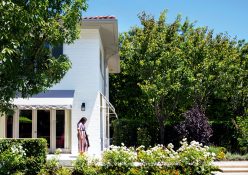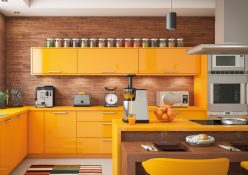Although living inside a box, it appears owner Bruno’s mind is very much outside of it – just take a look at this mountainside Capetonian home
t’s unusual to want live inside a box – or several, to be exact – but that’s exactly what Bruno Bossi required of his home’s architectural structure. Situated on a modest plot right on the mountainside in Cape Town, the house packs in an enormous open-plan living area and three en-suite bedrooms through the clever construction of spaces Bruno refers to as ‘three boxes piled on top of one another’. Bruno was integral in designing his home with architect Wolf of Wolf + Wolf Architects. Having travelled extensively, his design aesthetic was led by myriad inspirations, but minimal modernist buildings had the greatest influences.

The house presents a unique visual arrangement, one box appearing to hover above the ground when viewed from the street – a layout allowing for maximum light to penetrate the interior. However, Bruno says that what led the unconventional design was less about having a striking look and more about how he wanted the house to feel, his main motivation being to create the social ambience of a loft-style apartment, where everyone is always within earshot.
The boxes’ L-shape formation also allows his love of clean geometric lines to be apparent. ‘I wanted the functionality of a modernist space,’ he explains of the fluidity this home allows. ‘There are no passageways and there’s no foyer, so the entrance area is actually the outside deck,’ he adds, describing how the home he shares with girlfriend Talyn Perdikis was first modelled around purpose, and then around form. It’s therefore understandable that the interior staircase has no railings. ‘The anti-baby staircase,’ laughs Bruno, who has no children of his own. ‘If I don’t need something, why should I put it in?’

He credits Wolf with devising this essential connecting element of the home’s puzzle. ‘It was tricky to find the gap for the staircase when fitting the three boxes together,’ he says, indicating the route it follows from the dining area, over the kitchen, on to the mezzanine bedroom level and then up to the top-floor main bedroom. Made of concrete and black polished aggregate, this staircase presents itself as a main feature of the interior architecture, and you can clearly see how its skeletal configuration allows for more access to natural light. ‘All the glass makes you think the area behind the kitchen belongs to me, but it’s actually the neighbour’s garden,’ explains Bruno of the multitude of windows. ‘It’s like we’ve cheated the space, allowing more distance behind it, giving the home a greater sense of depth.’
Originally built around two gigantic oak trees, which fell down during a storm three years ago, the house remains enveloped by plenty of greenery and dazzling views of the city as well as two of Cape Town’s famous peaks, Table Mountain and Lion’s Head, which Bruno insisted on incorporating into the architectural design considerations. The property’s perimeter walls were kept relatively low to allow these mountainscapes to be visible from the ground- floor living area as its glass fronting provides full visual access
to the city’s natural bounty.

The mountain view’s what drew Bruno to the suburb in the first place. A keen mountain-biker, he’s also often seen walking Toska, his long-legged wire-haired Jack Russell, up to the summits. Back home, Toska can be found diving for trinkets in the swimming pool, a later addition to the house, built when a small adjoining property was purchased. A tree-covered wooden deck, adjacent to the pool and jutting out from the open living area is where many al fresco meals are enjoyed with friends and family.
Bruno’s love for carefully crafted handmade decor is prevalent all over the home, even the pool. Handmade tiles were crafted in the seaside town of Hermanus, specially commissioned to match the crockery set Bruno’s mother made for him back in 2002. This special collection of plates, bowls, cups and handcrafted teal-coloured mugs are usually part of conversation as guests sip coffee next to the swimming pool.

Proudly displayed in the kitchen, the ceramics sit finely amid the contrasting walnut cabinets and black Zimbabwean granite counters. It’s around the fireplace, in winter, when these mugs of coffee are most appreciated. It was constructed using the same concrete as the staircase and allows fire and the outdoors to be viewed in unison, continuing the home’s reverence for nature and its elements. There may seem to be a lack of clutter, but make no mistake, this house feels like home, no matter the season.

Subscribe to Livingspace, to receive monthly updates on all decor trends.





